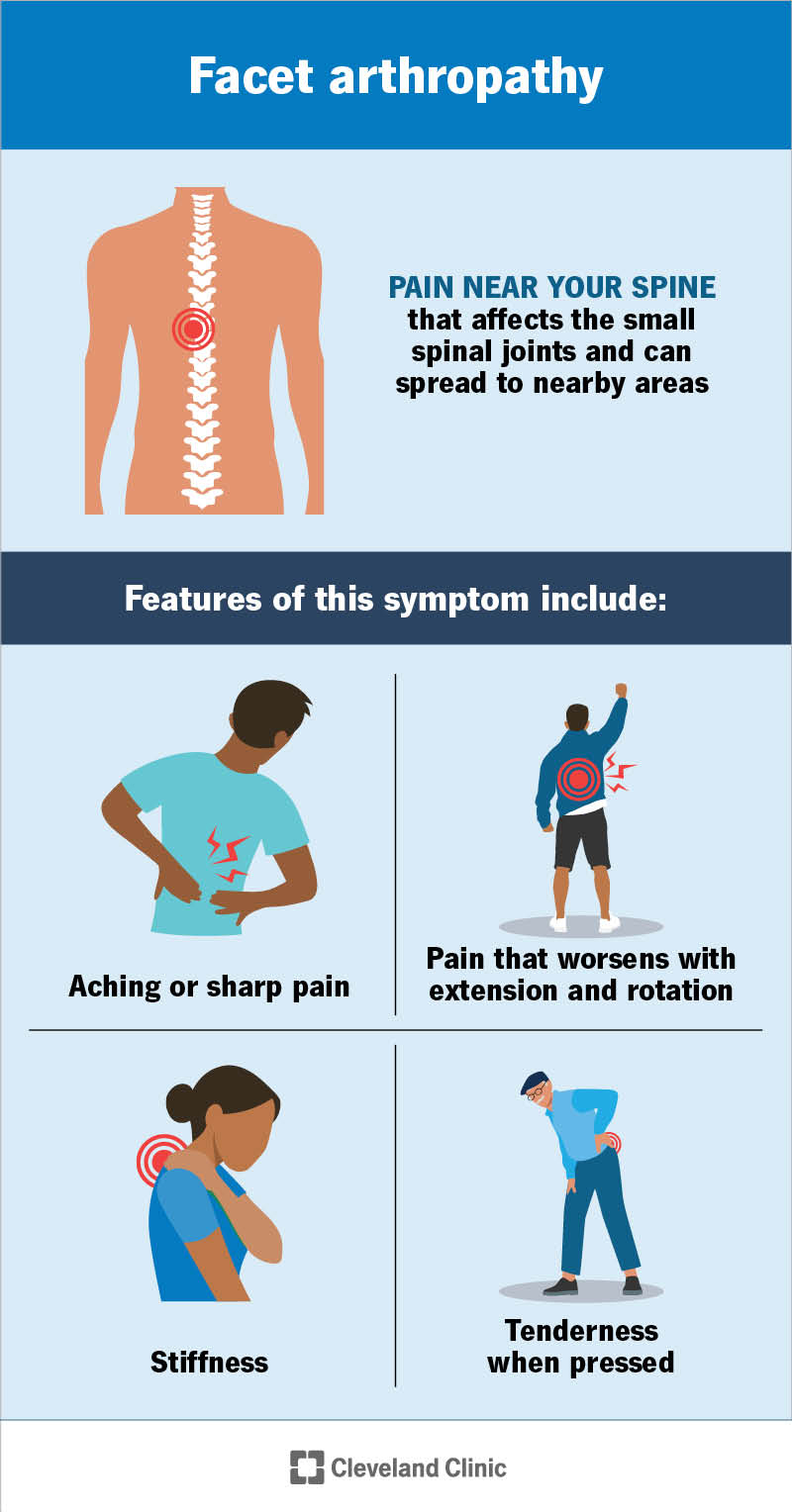Facet arthropathy is arthritis in the small joints of your spine. It can lead to back or neck pain, stiffness and limited movement. As cartilage breaks down, bones may rub together, causing pain and inflammation. Treatments like physical therapy and steroid injections can help manage symptoms.
Advertisement
Cleveland Clinic is a non-profit academic medical center. Advertising on our site helps support our mission. We do not endorse non-Cleveland Clinic products or services. Policy
Facet arthropathy is a type of arthritis that affects the small joints in your spine. Facet joints give your spine support and stability. They also guide movement, allowing you to bend and twist.
Advertisement
Cleveland Clinic is a non-profit academic medical center. Advertising on our site helps support our mission. We do not endorse non-Cleveland Clinic products or services. Policy
The ends of your spinal bones are covered with a smooth tissue called cartilage. It works like a cushion for your joints. Over time, cartilage can wear away. This makes your bones rub against each other. As a result, bone spurs (extra bone growths) and, sometimes, cysts (fluid-filled sacs) form.
If you have facet arthropathy, you might feel back or neck pain that gets worse when you make certain bending and twisting movements.
A healthcare provider can help you manage the chronic pain that this condition causes.
There aren’t specific types. You may instead hear your provider use these terms to describe the location of the affected joint:
There are also two ways arthritis affects each joint:

Pain near your spine is the main symptom. It usually affects the area around the joint but can spread to nearby areas. Sometimes, you may feel referred pain. This means the pain shows up in a different part of your body than where it starts.
When you have facet arthropathy, you might feel:
Advertisement
Facet arthropathy usually develops when the cartilage that cushions your facet joints wears down. This breakdown makes movement painful. The most common reasons for this include:
You may have a higher risk of this condition if you:
When the cartilage breaks down, your bones may rub against each other. This can lead to:
In rare cases, it may also cause spinal cord compression or cauda equina syndrome. Symptoms of these conditions can include arm or leg weakness or problems with bowel and bladder control.
A healthcare provider diagnoses facet arthropathy with a physical exam and tests. They’ll ask about your symptoms and medical history. Then, they’ll press gently on your spine to find the source of pain. To see the joints more clearly, they may order imaging tests, like a CT scan or MRI.
To confirm the diagnosis, your provider may inject a numbing medication into the nerves that supply the affected joint. If your pain improves while the medication is active, it shows that facet arthropathy is the cause.
Your provider may use a grading system to describe how severe the condition is:
Different providers use different grading systems. Speak up if you’re not sure what your diagnosis means.
Treatment for facet arthropathy may include:
Advertisement
If these don’t provide enough relief, your provider may recommend:
Living with chronic pain isn’t easy. You may benefit from speaking with a mental health provider. They can help you find coping strategies to manage day-to-day challenges.
See a healthcare provider if you have chronic back pain that doesn’t improve with self-care, keeps getting worse or just won’t go away.
Facet arthropathy usually gets worse over time. Once the joints start to degenerate, you can’t reverse the damage. Treatment can help manage symptoms. You might only notice pain with flare-ups after certain movements or when treatment wears off.
Advertisement
A healthcare provider will work with you, so pain doesn’t take over your daily routine.
You can’t fully prevent this condition. Everyone’s facet joints wear down a bit with age. But you can lower your risk by:
Facet syndrome and facet arthropathy are related but not the same. Facet syndrome refers to pain and other symptoms from a facet joint problem. Facet arthropathy is the degeneration, or breakdown, of the facet joint itself. Facet arthropathy can cause facet syndrome.
Back pain that lasts longer than you’d like can feel frustrating and draining. Facet arthropathy is one possible cause, especially if twisting makes the pain worse. But living with pain doesn’t have to be your norm. This condition is manageable, and you have options.
From physical therapy to pain-relieving injections — and even treatments that calm the nerves sending pain signals — your provider can help you find a plan that fits your needs. If pain starts to affect your mood or daily routine, it’s also OK to reach out for mental health support.
Advertisement
You don’t have to push through chronic pain without help. With the right care and small changes, you can keep moving and stay connected to what matters most to you.
Back pain can stop you in your tracks. But you don’t have to live like that. Cleveland Clinic is here to help you get moving again.

Last reviewed on 11/18/2025.
Learn more about the Health Library and our editorial process.